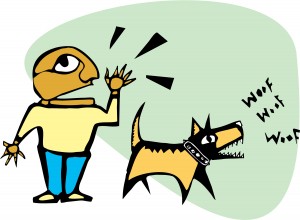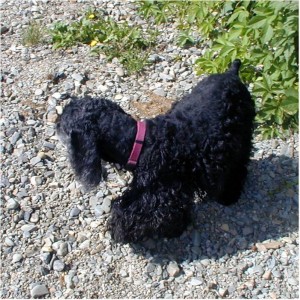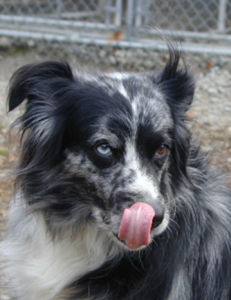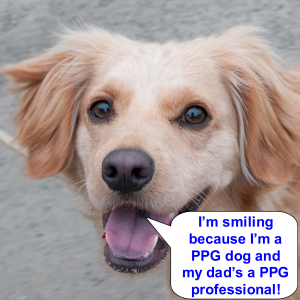< Updated 14JAN20 >
< A short link to this page – http://bit.ly/BarkingHelp >
Barking is the way dogs express an emotion of some kind. In order to be able to reduce it, we need to know why the dog is barking. – Turid Rugaas, Barking: The Sound of A Language, Dogwise Publishing, 2008
OBJECTIVE: To understand and resolve issues with a dog whose barking is disruptive.
Barking is one of many forms of vocalization used by dogs to communicate with one another as well as with us and other living things. Some individual dogs and some breeds of dogs tend to bark more frequently than others.
Barking is a complex behavior, meaning there are several reasons that your dog may bark. He may be barking to alert you that something or someone is approaching. A dog may bark to obtain something such as a treat or attention. He may bark to tell you that he needs to go outside to go to the bathroom. Many dogs bark because they have been left alone and are frustrated, bored or anxious.
Like any behavior, a dog barks because they find the result of their barking to be rewarding. For example, your dog may repeatedly bark if they get anxious or upset when strangers enter their territory; like the postal carrier delivering the daily mail or children gathering at the end of your driveway as they wait for the school bus. The dog barks and barks. “Intruder!!!” “Go away!!!” Shortly after that the postal carrier and children leave, not because of your dogs barking, but that’s not how your dog sees it. From the dogs perspective, he has just driven away the invaders in his territory. That is a huge reward!
Moreover, if this happens 5 to 6 times a week, as it could be in the above example, your dogs barking becomes a learned behavior, and it becomes even stronger and more likely to occur again. Behavior that works is repeated. Lastly, some dogs can also bark for the pure joy of it. In this case, the behavior is self-reinforcing and can be even more difficult to control.
NOTE: Do NOT get into a barking contest with your dog. All too often we inadvertently contribute to our dogs barking by yelling back at them. If your dog does not stop barking and you yell louder, your dog gets more excited and thus barks more. This will rapidly become a vicious circle. Also, please understand that the phrase “No Bark” means nothing to your dog unless you have trained them to respond a cue and then rewarded them for their response.
Punishing your dog for barking; yelling at them, throwing something at them, using a shake can or an anti-barking collar, or anything else that the dog may perceive as aversive, typically will not resolve the barking and will often make it worse. Aversives cause fear and anxiety, which are a common cause of excessive barking in dogs. Green Acres Kennel Shop, as well as the American Animal Hospital Association (AAHA) and the Pet Professional Guild (PPG), all strongly, recommend against the use of aversives for training or behavior modification.
“This Task Force opposes training methods that use aversive techniques. Aversive training has been associated with detrimental effects on the human–animal bond, problem solving ability, and the physical and behavioral health of the patient. It causes problem behaviors in normal animals and hastens progression of behavioral disorders in distressed animals. Aversive techniques are especially injurious to fearful and aggressive patients and often suppress signals of impending aggression, rendering any aggressive dog more dangerous. Aversive techniques include prong (pinch) or choke collars, cattle prods, alpha rolls, dominance downs, electronic shock collars, lunge whips, starving or withholding food, entrapment, and beating. None of those tools and methods should be used to either teach or alter behavior. Non aversive techniques rely on the identification and reward of desirable behaviors and on the appropriate use of head collars, harnesses, toys, remote treat devices, wraps, and other force-free methods of restraint. This Task Force strongly endorses techniques that focus on rewarding correct behaviors and removing rewards for unwanted behaviors.” – from the AAHA Canine and Feline Behavior Management Guidelines, published August 2015, [Emphasis added]
The US Food and Drug Administration has issued the following statement on the use of shock-collars for stopping barking: “A veterinary device which has been the subject of regulatory attention is a dog collar which is activated by barking resulting in an electric shock to the dog which supposedly trains him to stop barking. *CVM* believes the collars fall under the definition of a device since they are intended to affect barking, which is a natural dog function. Complaints received, which were later corroborated by our own testing, included severe burns in the collar area and possible personality adjustment injuries to the dogs. The shocking mechanism was found to be activated not only by barking but by vehicle horns, slamming doors or any other loud noise. *CVM* concurred in regulatory action against the device since it was deemed to be dangerous to the health of the animal. POLICY: Dog collars which are activated by the noise of barking to produce an electric shock are considered as hazardous to the health of the animal.” (USFDA-Inspections, Compliance, Enforcement, and Criminal Investigations-CPG Sec. 655.300 Barking Dog Collar, issued 10/1/80, revised 8/2/87) [Emphasis added]
As behaviorist Turid Rugaas so aptly noted in the quote at the beginning of this article, before we can deal with a dogs barking we first need to understand why they are barking. In her book Barking: The Sound of A Language, she recommends that the first step in getting your dogs barking under control is to keep a chart of your dogs barking so that you can better determine the cause. Things you will need to record are: the date, the time barking starts, the time barking stops, a description of what the bark sounds like, where is your dog located, what the dog is doing (are they in motion?, what are they looking at?, what does their body language tell you?), and what do you believe has triggered the dogs barking. An entry might look like this:
4/6/15 – 6:55AM to 7:10AM, Woof, quiet, woof, then escalates to continuous barking, Rex is at the front window and the front door, He is racing from the window to door barking, his body posture is forward and stiff, He started barking as soon as the postal carriers vehicle stopped by my mailbox.
Many people find it helpful to work with a Certified Dog Behavior Consultant (CDBC) in developing a behavior modification plan to reduce excessive barking. Barking is the result of an emotional response so training the dog a new behavior will seldom be sufficient to resolve the barking unless we also help the dog to have a positive emotional response. Barking is complex and having a thorough understanding of normal and abnormal canine behaviors is often necessary to determine why the barking is reinforcing to the dog. You can learn more about Green Acres Behavior Consulting services at our website ( www.greenacreskennel.com )or by calling us at 207-945-6841.
Recommended Resources
Articles on Don’s Blog ( http://www.words-woofs-meows.com )
Book Review: Barking: The Sound of a Language by Turid Rugaas – http://bit.ly/BookRvw-Rugass-Barking
Reward Based Training versus Aversives – http://bit.ly/RewardVSAversive
How Can I Tell When My Dog Is Anxious or Fearful? – http://bit.ly/DogsSignsofFear
Help! My Dog is Aggressive, Reactive, Fearful, Anxious, etc. – What do I do? – WWM – APR2017 – http://bit.ly/HelpDogAggx
What Is A Pet Behavior Consultant? – http://bit.ly/WhatIsPetBhxConsulting
________________________________________________________________________
Don Hanson is the co-owner of the Green Acres Kennel Shop ( greenacreskennel.com ) in Bangor, Maine where he has been helping people with their pets since 1995. He is a Bach Foundation Registered Animal Practitioner (BFRAP), Certified Dog Behavior Consultant (CDBC), Associate Certified Cat Behavior Consultant (ACCBC) and a Certified Professional Dog Trainer (CPDT-KA). Don is a member of the Pet Professional Guild (PPG) and is committed to PPG’s Guiding Principles and the Pain-Free, Force-Free, and Fear-Free training, management, and care of all pets. Don produces and co-hosts a weekly radio show and podcast, The Woof Meow Show heard on AM620 WZON and streamed at http://www.wzonam.com/ every Saturday at 9 AM. Podcasts of the show are available at http://woofmeowshow.libsyn.com/. Don also writes about pets at his blog: www.words-woofs-meows.com. The opinions in this post are those of Don Hanson.
©14JAN20, Donald J. Hanson, All Rights Reserved
< Click for Copyright and Use Policy >









